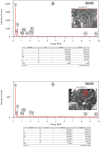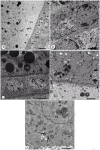Relative expression of microRNAs, apoptosis, and ultrastructure anomalies induced by gold nanoparticles in Trachyderma hispida (Coleoptera: Tenebrionidae)
- PMID: 33156883
- PMCID: PMC7647063
- DOI: 10.1371/journal.pone.0241837
Relative expression of microRNAs, apoptosis, and ultrastructure anomalies induced by gold nanoparticles in Trachyderma hispida (Coleoptera: Tenebrionidae)
Abstract
The extensive use of nanomaterials generates toxic effects on non-target species and the ecosystem. Although gold nanoparticles (Au-NPs) are generally expected to be safe, the recent study contains conflicting data regarding their cytotoxicity in the darkling beetles Trachyderma hispida. The study postulated cellular perturbation in the ovarian tissue of the beetles induced by a sublethal dose of Au-NPs (0.01 mg/g). When compared with the controls, a significant inhibition in the activities of the antioxidant enzymes selenium-dependent (GPOX) and selenium-independent (GSTP) glutathione peroxidases (GPx) was observed in the treated beetles. The study proposed microRNAs (miRNA-282 and miRNA-989) as genotoxic markers for the first time, reporting a significant suppression in their transcriptional levels in the treated beetles. Furthermore, TUNEL (Terminal deoxynucleotidyl transferase-mediated dUTP nick end labeling) and flow cytometry assays (annexin V-Fitc) indicated a significant increase in ovarian cell apoptosis in the treated beetles. Additionally, an ultrastructure examination revealed pathological changes in the ovarian cells of the treated beetles. The resulting anomalies in the present study may interrupt the fecundity of the beetles and lead to the future suppression of beetle populations.
Conflict of interest statement
The authors have declared that no competing interests exist.
Figures








Similar articles
-
Oxidative stress parameters, DNA damage and expression of HSP70 and MT in midgut of Trachyderma hispida (Forskål, 1775) (Coleoptera: Tenebrionidae) from a textile industry area.Environ Pollut. 2020 Dec;267:115661. doi: 10.1016/j.envpol.2020.115661. Epub 2020 Sep 17. Environ Pollut. 2020. PMID: 33254610
-
Fabrication of biosynthesized nickel ferrites nanoparticles and evaluation of their insecticidal efficacy on beetles (Blaps polychresta) testicular integrity.Sci Rep. 2025 Feb 28;15(1):7214. doi: 10.1038/s41598-025-90496-0. Sci Rep. 2025. PMID: 40021762 Free PMC article.
-
Nickel oxide nanoparticles induce genotoxicity and cellular alterations in the ground beetle Blaps polycresta (Coleoptera: Tenebrionidae).Toxicol Ind Health. 2021 Jul;37(7):408-430. doi: 10.1177/07482337211000988. Epub 2021 Jun 4. Toxicol Ind Health. 2021. PMID: 34085874
-
DNA damage and ovarian ultrastructural lesions induced by nickel oxide nano-particles in Blaps polycresta (Coleoptera: Tenebrionidae).Sci Total Environ. 2021 Jan 20;753:141743. doi: 10.1016/j.scitotenv.2020.141743. Epub 2020 Aug 17. Sci Total Environ. 2021. PMID: 32891989
-
MicroRNAs as Potential Regulators of Glutathione Peroxidases Expression and Their Role in Obesity and Related Pathologies.Int J Mol Sci. 2018 Apr 14;19(4):1199. doi: 10.3390/ijms19041199. Int J Mol Sci. 2018. PMID: 29662007 Free PMC article. Review.
Cited by
-
Impacts of Combining Steinernema carpocapsae and Bracon hebetor Parasitism on Galleria mellonella Larvae.Insects. 2024 Aug 1;15(8):588. doi: 10.3390/insects15080588. Insects. 2024. PMID: 39194793 Free PMC article.
-
Emerging alternatives to traditional anthelmintics: the in vitro antiparasitic activity of silver and selenium nanoparticles, and pomegranate (Punica granatum) peel extract against Haemonchus contortus.Trop Anim Health Prod. 2023 Sep 22;55(5):317. doi: 10.1007/s11250-023-03722-0. Trop Anim Health Prod. 2023. PMID: 37737938 Free PMC article.
-
Nanopesticides for managing primary and secondary stored product pests: Current status and future directions.Heliyon. 2025 Jan 30;11(4):e42341. doi: 10.1016/j.heliyon.2025.e42341. eCollection 2025 Feb 28. Heliyon. 2025. PMID: 40034316 Free PMC article. Review.
-
Assessing the toxicity of green Agaricus bisporus-based Cadmium Sulfide nanoparticles on Musca domestica as a biological model.Sci Rep. 2024 Sep 14;14(1):21519. doi: 10.1038/s41598-024-70060-y. Sci Rep. 2024. PMID: 39277622 Free PMC article.
-
MiRNA Omics Reveal the Mechanisms of the Dual Effects of Selenium Supplementation on the Development of the Silkworm (Bombyx mori).Int J Mol Sci. 2025 Apr 4;26(7):3394. doi: 10.3390/ijms26073394. Int J Mol Sci. 2025. PMID: 40244248 Free PMC article.
References
Publication types
MeSH terms
Substances
LinkOut - more resources
Full Text Sources
Research Materials

